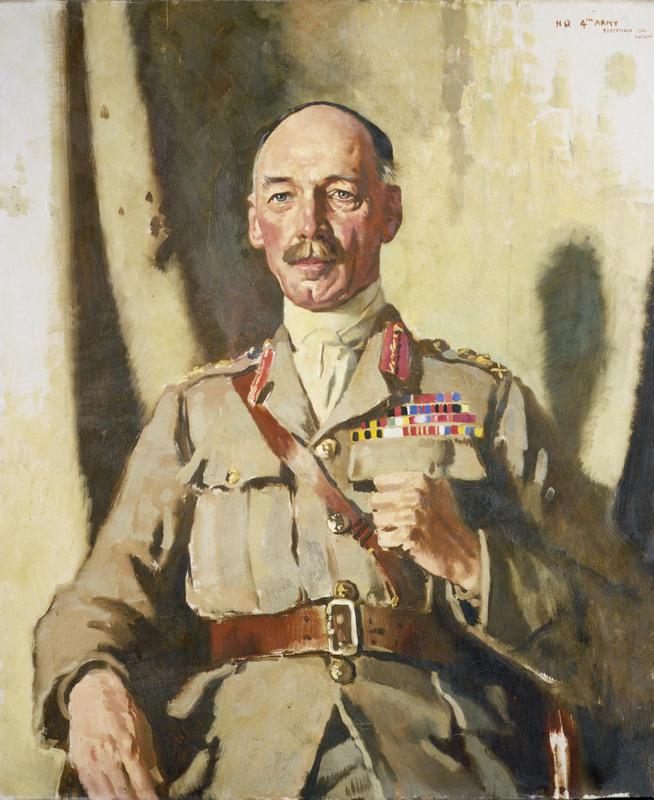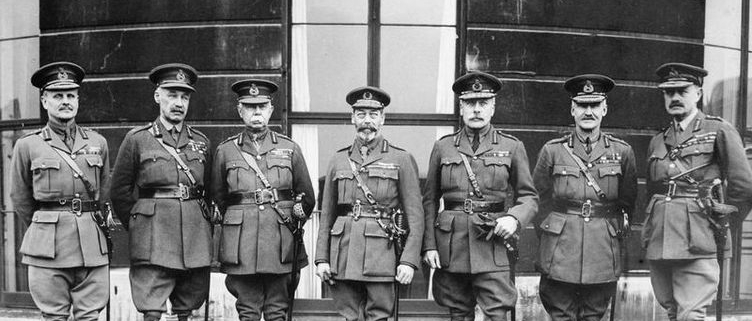The Dorset Soldier Who Won The First World War
On Tuesday 01 November at 2.30p.m. Dr Rodney Atwood will talk at Gold Hill Museum about the life and career of Henry Seymour Rawlinson (1864-1925), created Baron Rawlinson of Trent, Dorset, in 1919. ‘Rawly’ (second from the left, above) was a career professional soldier who in 1914 commanded a significant part of the small British Expeditionary Force in Belgium facing the overwhelming numerical superiority of invading German armies. By 1916 he was in command of the new and inexperienced Fourth Army which was badly mauled on the first day of the Somme. The catastrophic losses – 57,000 in total, of whom 19,000 were killed – helped create a lasting perception of military incompetence on the part of British top brass. A succession of writers has reinforced this stereotype.
A decorated serving officer, war poet Siegfried Sassoon almost certainly did NOT have Rawlinson in mind when he wrote The General in 1917:
“Good-morning; good-morning!” the General said
When we met him last week on our way to the line.
Now the soldiers he smiled at are most of ’em dead,
And we’re cursing his staff for incompetent swine.
“He’s a cheery old card,” grunted Harry to Jack
As they slogged up to Arras with rifle and pack.
But he did for them both by his plan of attack.
In 1961 Alan Clark published The Donkeys. This was a lively, if not particularly scholarly, account of how the B.E.F was allegedly mismanaged to destruction in 1915. His memorable title was taken from a conversation attributed to two German generals:
Ludendorff: “The English soldiers fight like lions.”
Hoffman: “True. But don’t we know that they are lions led by donkeys.”
Clark claimed that the source for his quote was the memoirs of a third German general, Falkenhayn. As no-one subsequently has been able to find this quote, the suggestion is that Clark made it up.
By 1989 Richard Curtis and Ben Elton were able to construct an entire comedy series Blackadder Goes Forth on the premise that the strategy of Sir Douglas Haig (third from the right, above) was ‘to move his drinks cabinet six inches closer to Berlin.’ A walrus-moustached Stephen Fry portrayed the entirely fictitious General Melchett as a braying jackass.

We are assured of a balanced assessment of Rawlinson’s career from Rodney Atwood, whose biography of General Lord Rawlinson – From Tragedy to Triumph was published by Bloomsbury in 2018. With the benefit of hindsight, we know that the Allies defeated Germany in 1918. This prospect was far from Allied minds when Germany, having forced Russia out of the war and no longer having to fight on two fronts, was able to mount a Spring offensive. Rodney will also give due consideration to non-military aspects of Rawly’s story. He was an accomplished artist and went on painting trips with another amateur painter, Winston Churchill, who acknowledged Rawlinson’s superior talent. He is buried in St Andrew’s Church, Trent, in the Yeo valley near Sherborne.
This illustrated lecture is free to S&DHS members and open to the public, on payment of £3 at the door.
There are biographical entries for most of the First World War Fallen named on local War Memorials at Shaftesbury Remembers The Great War



